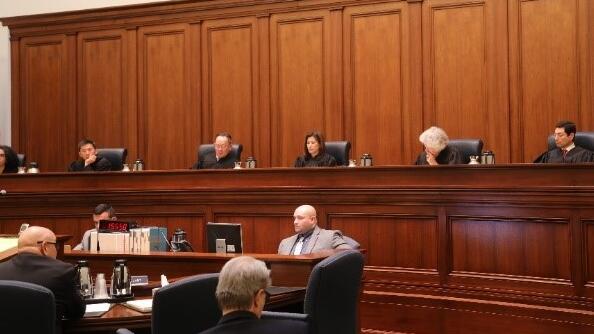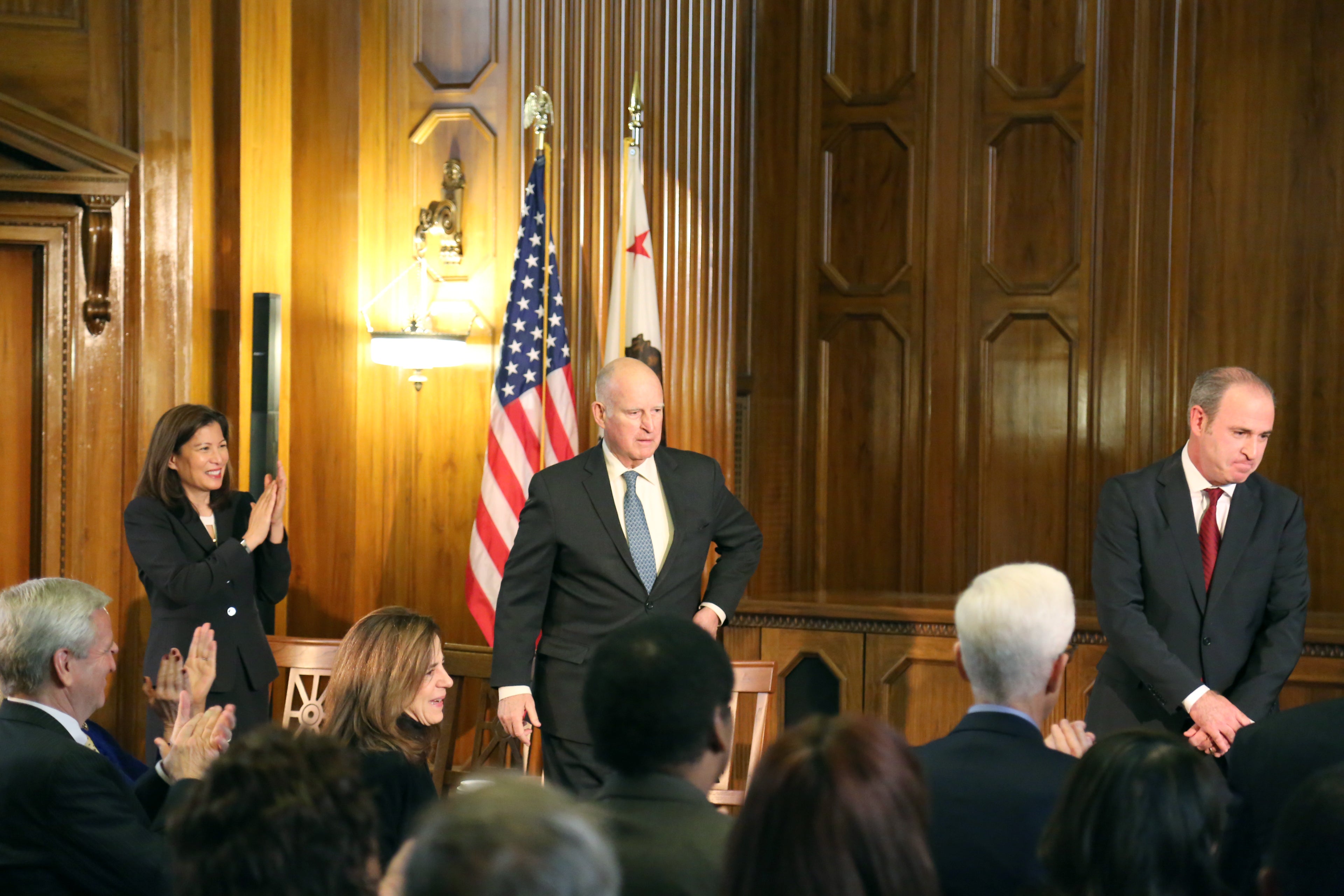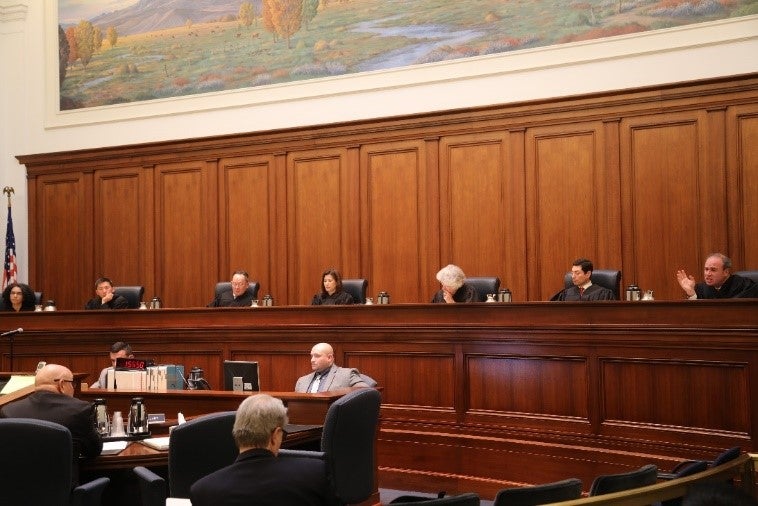
A Year in Review: the California Supreme Court
A New Justice Takes the Bench

Justice Joshua Groban is sworn in, with Chief Justice Tani Cantil-Sakauye and former Gov. Jerry Brown.
After an unprecedented 16-month vacancy, the Supreme Court welcomed its seventh member—Justice Joshua P. Groban. Groban took the bench for oral arguments just five days after being sworn in by former Gov. Jerry Brown.
“I am joining an institution whose fundamental purpose is to provide stability and consistency,” Groban said. “I look forward to doing that with a sense of reflection, respect, fidelity to the law, and compassion.”
The “other Josh Groban,” a multiplatinum record selling singer, congratulated the new justice on Twitter:
My “big break” was being asked to sing at Gov. Davis’s inauguration in Sacramento 20 years ago. If you don’t think the universe is playing a fun wacky game with us you’re wrong. And congrats to the other JG. https://t.co/bj16F8gR8N
— josh groban (@joshgroban) January 3, 2019
Before joining the bench, Justice Groban served as the governor’s Judicial Appointments Secretary, helping Brown transform the state judiciary through the appointment of nearly 650 judges, lauded for being the most diverse array of judicial appointees in California’s history.
The Work of the Court
The California Supreme Court issued 75 majority written opinions during the court year (see "High-Profile Cases" below).
To get there, the court considered nearly 7,200 filings, including about 3,900 petitions for review from approximately 18,000 judgments of the six District Courts of Appeal. Those appellate courts are the forum for reviewing close to 5 million judgments and orders in matters handled by the state’s 2,000 judicial officers.
On average, the court acted on 188 matters at each petition conference, at which the justices confer about three times per month.
Courtroom as Classroom
Nearly 500 students, ranging from middle schoolers to law school students, got a front row seat to Supreme Court oral arguments in Los Angeles, Sacramento and San Francisco.
The 16 school groups included international student visitors from Germany, Brazil, Mexico, China, Japan, the Netherlands, South Africa, and France.
For the third year, the court live streamed its oral argument sessions, with real-time captioning in both English and Spanish. The live stream each year gives access to tens of thousands of attorneys, law students, journalists and the public to watch the court live or view archived videos of past sessions. Most of California’s appellate courts have followed suit by live streaming oral arguments to the public.Justice Goodwin Liu speaks to San Francisco middle schoolers about the work of the Supreme Court.
Pardons & Commutations
Under the state Constitution, the Governor must obtain get the “recommendation” of the majority of Supreme Court justices to pardon or commute the sentence of someone convicted of two or more felonies. The court acted on 68 requests for pardons or commutations, the vast majority during former Gov. Jerry Brown’s final weeks in office. Of those, the court declined to allow clemency in 10 matters — the first rejections in many decades.
In August, the court allowed clemency in Gov. Gavin Newsom’s first request. The Governor then pardoned Susan Burton, who had served 20 years in prison before creating a nonprofit that helps women transitioning out of prison.
Death Penalty Cases
Death penalty appeals are based primarily on the record at trial. These appeals of trial court decisions bypass the Courts of Appeal and are decided exclusively by the California Supreme Court. The court decided 20 automatic appeals by written opinions this year.
Historically, the state Supreme Court decided habeas corpus challenges to death judgments, which are generally based on evidence and allegations outside the trial record. Although the Supreme Court resolved 16 capital habeas corpus petitions this year, under recently enacted Proposition 66, there is now a preference for such petitions to be ruled on initially in the superior courts. Accordingly, this year the Supreme Court also transferred 121 habeas corpus petitions to the trial courts that imposed the original death sentence.
High-Profile Cases
-
In Association for Los Angeles Deputy Sheriffs v. Superior Court, the court considered whether law enforcement agencies may tell prosecutors that an officer’s confidential personnel records might contain information that criminal defendants are entitled to receive under the federal Constitution. The court ruled that a state confidentiality statute does not forbid such disclosures, at least if the officer is a potential witness in a pending prosecution. (Watch)
-
Generally, the police must get a warrant supported by probable cause before conducting a search—unless there is an exception. In People v. Ovieda, the court overruled one of its own prior cases and held that there is no non-emergency “community caretaking” exception to the warrant requirement. (Watch)
-
In CalFire Local 2881 v. CALPERS, the court upheld a provision of the California Public Employees’ Pension Reform Act of 2013 that ended the practice of allowing public employees to enhance their pension benefits by buying up to five years of extra service credit. The court concluded that because the opportunity to purchase service credit is not subject to the constitutional protections applicable to more typical public employee pension rights, the Legislature can alter or eliminate the opportunity at its discretion. (Watch)
-
In City and County of San Francisco v. The Regents of the University of California, the court addressed a tax issue of importance to local government. The decision held that a city and county may lawfully require a public state university that operates paid parking lots in the city to collect a tax from drivers who park their cars in those lots, and the university can be required to remit those funds to the city. (Watch)
-
In White v. Square, Inc., the court answered a question submitted by the Ninth Circuit regarding California's Unruh Civil Rights Act: Does a plaintiff have “standing” (the right to file and litigate a lawsuit) when the plaintiff visits a business’s website intending to use its services and encounters terms and conditions that allegedly deny the plaintiff full and equal access to the website’s services, and then leaves the website without agreeing to those terms and conditions? The court answered yes, explaining that a plaintiff who visits a business’s website with intent to use its services does not need to enter into an agreement with the business to sue under the Unruh Act for unlawful discrimination. (Watch)
-
A unanimous decision from the prior term, Dynamex Operations West, Inc. v. Superior Court, articulated a test to decide whether workers should be characterized as employees or independent contractors. Recently, the Legislature codified a version of that decision by passing Assembly Bill 4, and Gov. Gavin Newsom signed the bill into law last month. (Watch)
|
Action/Category |
Number |
|---|---|
|
Opinions |
75 |
|
Filings |
6,615 |
|
Dispositions |
7,167 |
|
Death Penalty Habeas Corpus: Order to Show Cause |
3 |


